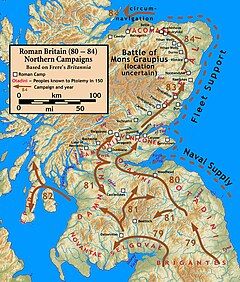Mons Graupius
| Battle of Mons Graupius | |||||||
|---|---|---|---|---|---|---|---|
| Part of Roman conquest of Britain | |||||||
 |
|||||||
|
|||||||
| Belligerents | |||||||
| Roman Empire | Caledonian Confederacy | ||||||
| Commanders and leaders | |||||||
| Agricola | Calgacus | ||||||
| Strength | |||||||
| 17,000-30,000+ | 15,000-30,000+ | ||||||
| Casualties and losses | |||||||
| 360 | 10,000 | ||||||
The Battle of Mons Graupius was, according to Tacitus, a Roman military victory in what is now Scotland, taking place in AD 83 or, less probably, 84. The exact location of the battle is a matter of debate. Historians have long questioned some details of Tacitus's account of the fight, suggesting that he exaggerated Roman success.
According to Tacitus, Gnaeus Julius Agricola, who was the Roman governor and Tacitus's father-in-law, had sent his fleet ahead to panic the Caledonians, and, with light infantry reinforced with British auxiliaries, reached the site, which he found occupied by the enemy.
Even though the Romans were outnumbered in their campaign against the tribes of Britain, they often had difficulties in getting their foes to face them in open battle. The Caledonii were the last unconquered British tribe (and were never fully subdued). After many years of avoiding the fight, the Caledonians were forced to join battle when the Romans marched on the main granaries of the Caledonians, just as they had been filled from the harvest. The Caledonians had no choice but to fight, or starve over the next winter.
According to Tacitus, allied auxiliary infantry, 8,000 in number, were in the center, while 3,000 cavalry were on the flanks, with the Roman legionaries in front of their camp as a reserve. Estimates for the size of the Roman army range from 17,000 to 30,000; although Tacitus says that 11,000 auxiliaries were engaged, along with a further four squadrons of cavalry, the number of legionaries in reserve is uncertain. The Caledonian army, which Tacitus claims was led by Calgacus (Tacitus only mentions him as giving a speech, probably fictitious), was said to be over 30,000 strong. It was stationed mostly on higher ground; its front ranks were on the level ground, but the other ranks rose in tiers, up the slope of the hill in a horseshoe formation. The Caledonian chariotry charged about on the level plain between the two armies.
...
Wikipedia
